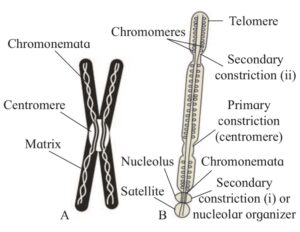1. Chromosomes represent the densely packed form of DNA, facilitated by histone proteins H1, H2A, H2B, H3, and H4, visible during metaphase in cell division.
2. Eukaryotic chromosomes have two arms, termed p-arm and q-arm, with a central constriction called the centromere where spindle fibers attach during cell division.
3. The centromere’s location categorizes chromosomes as metacentric, submetacentric, acrocentric, or telocentric, influencing their structural characteristics.
4. Chromosomes feature telomeres at arm ends, highly condensed like centromeres, contributing to genetic stability.
5. The centromere’s position dictates the chromosome type, impacting its behavior during cell division.
6. Chromosomes display heterochromatin (highly condensed) and euchromatin (less condensed) regions, regulating gene activity.
7. During metaphase, chromosomes condense, facilitating their organized alignment for proper cell division.
8. The intricate structure of chromosomes ensures the efficient packaging of lengthy DNA within the cell nucleus.

Structure of chromosome